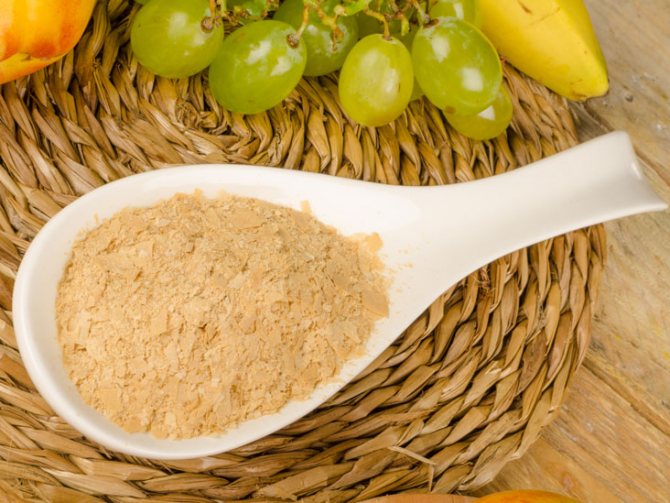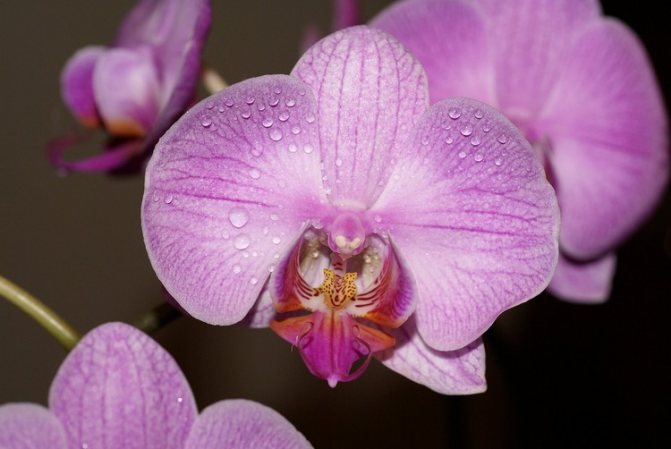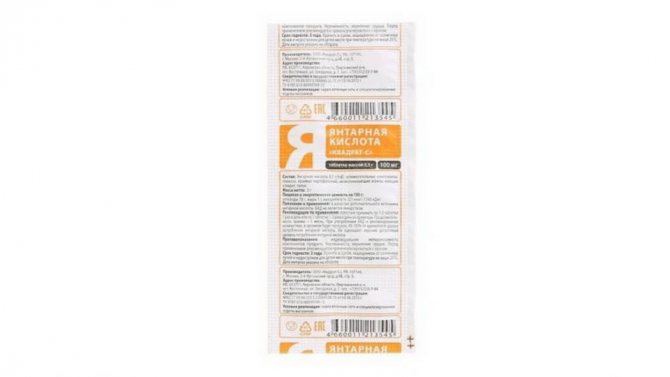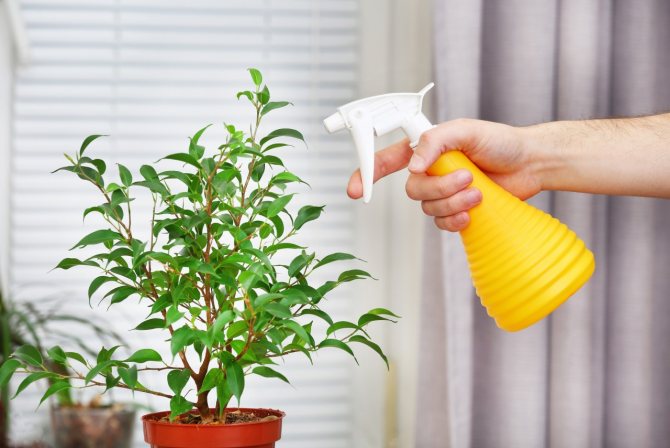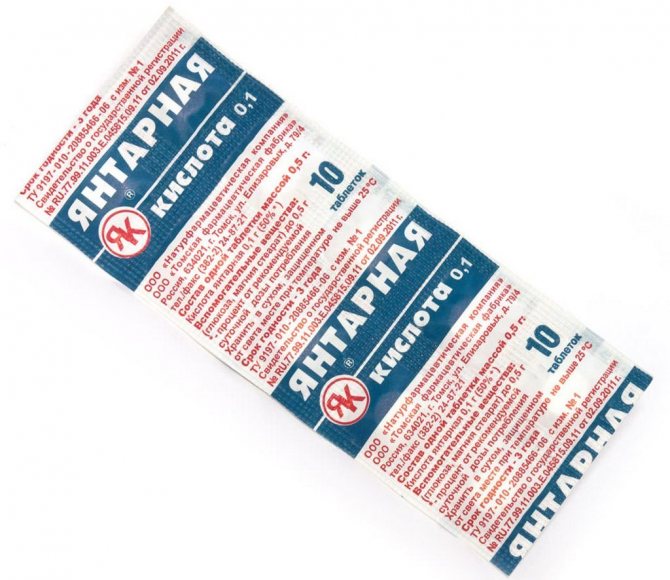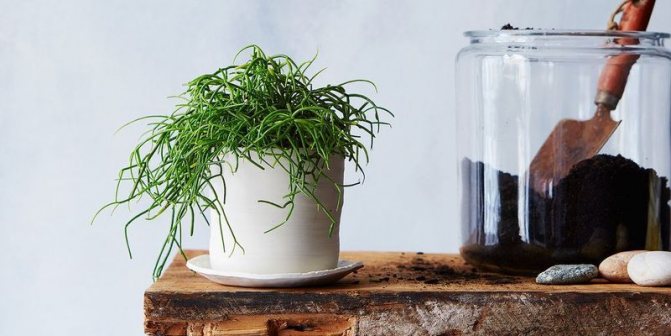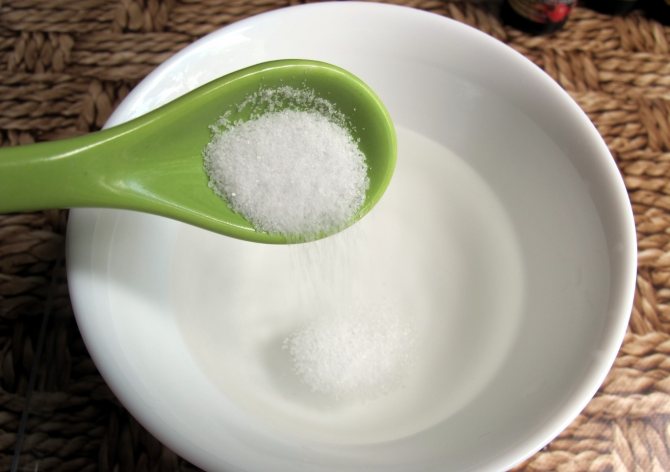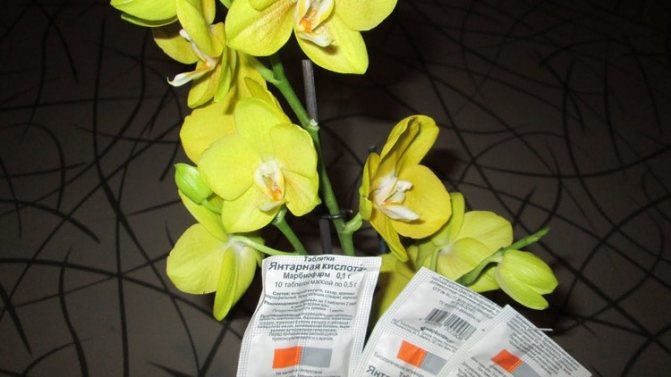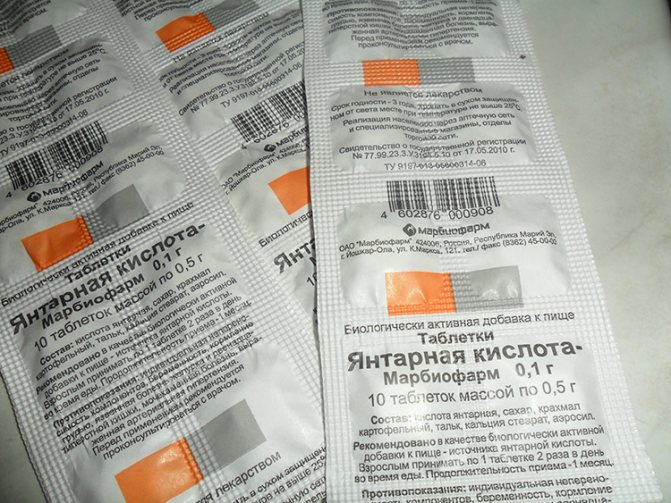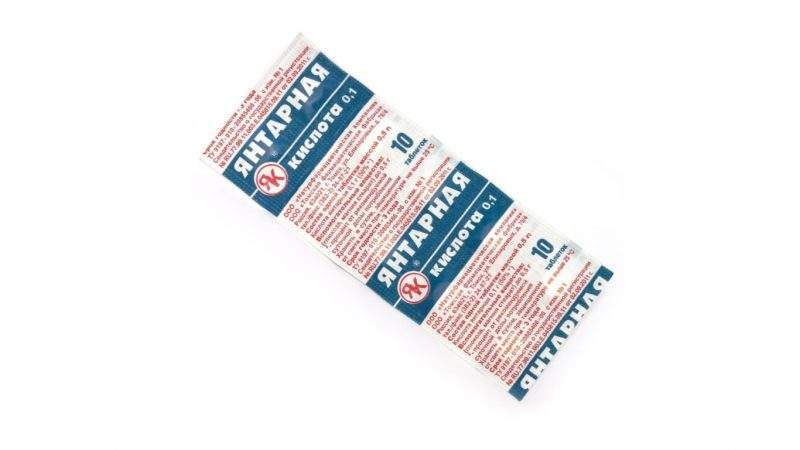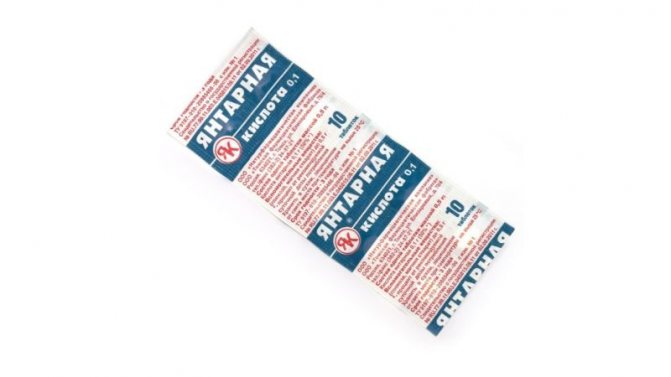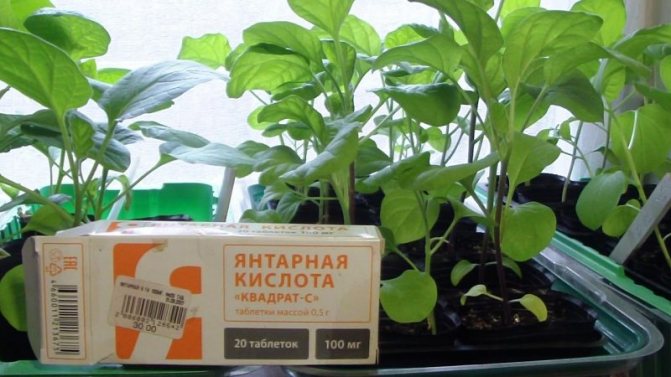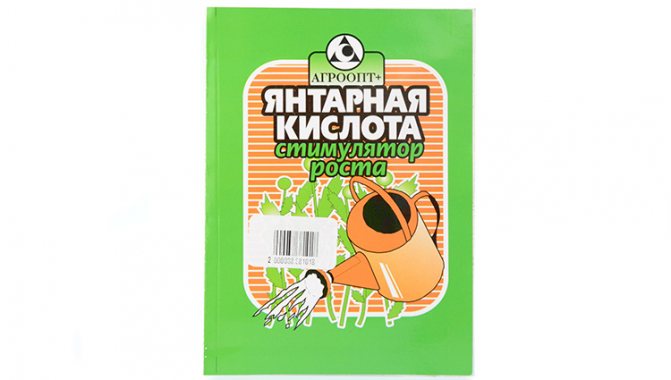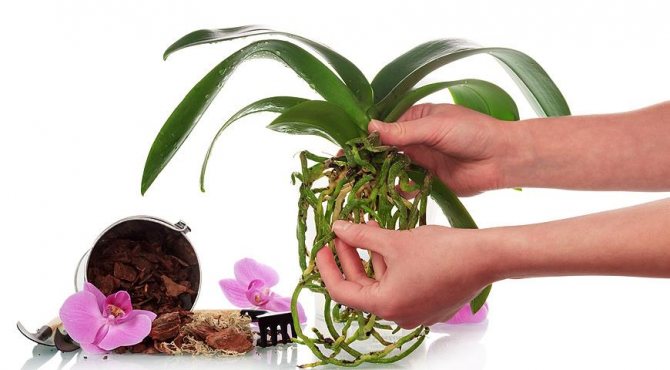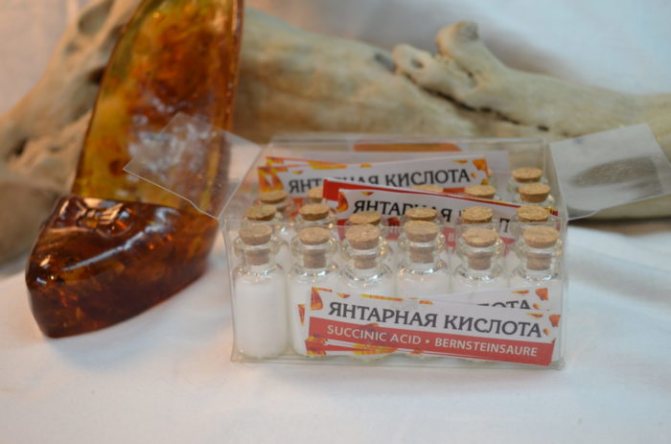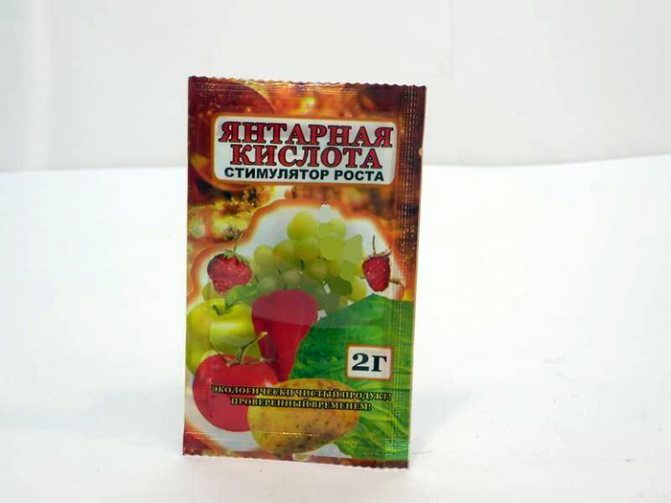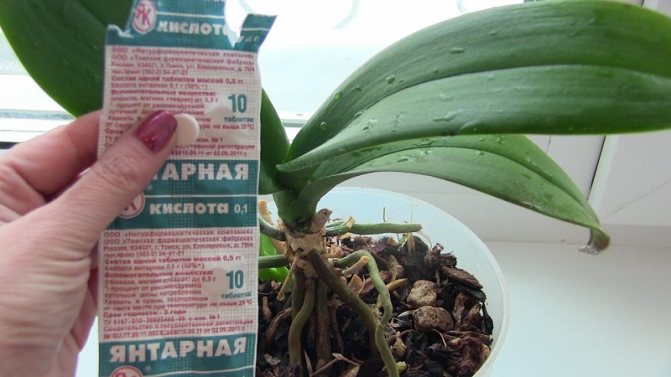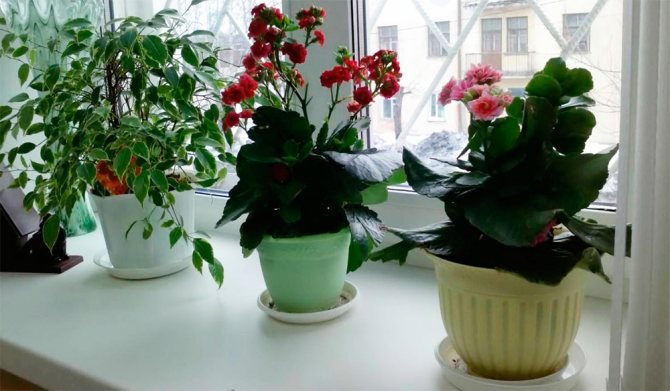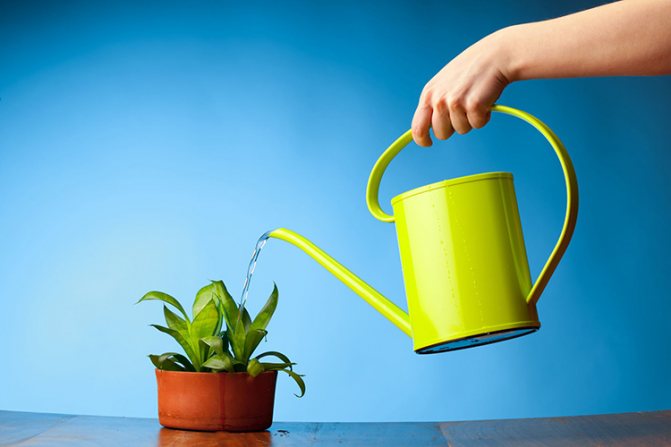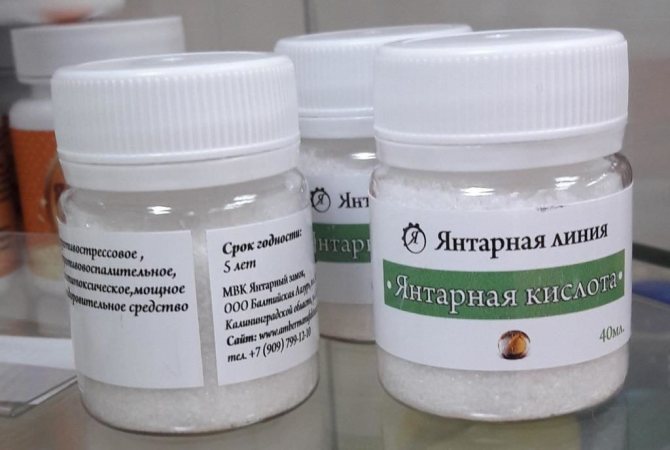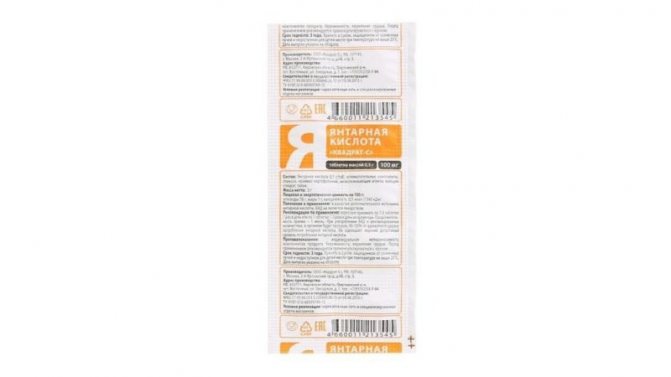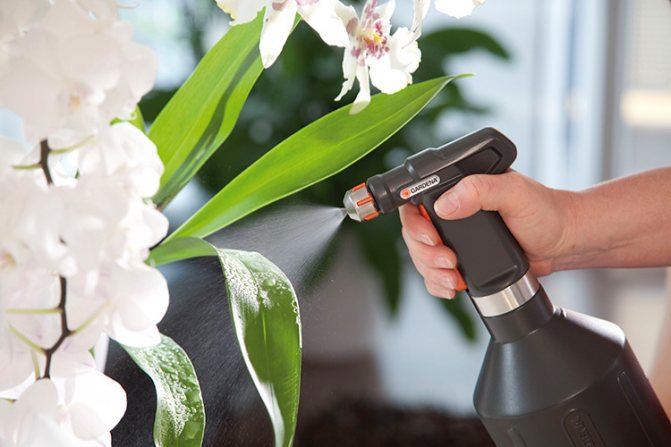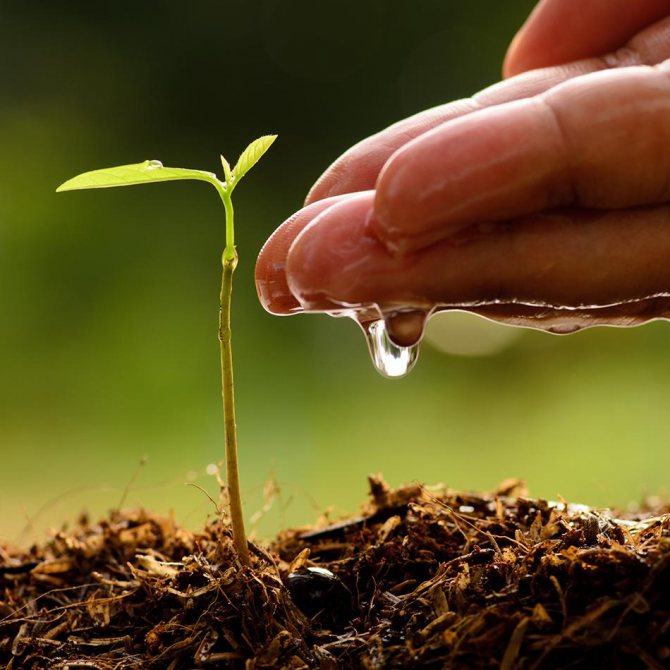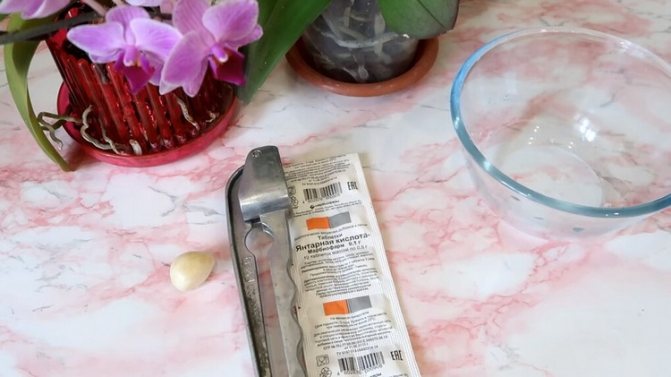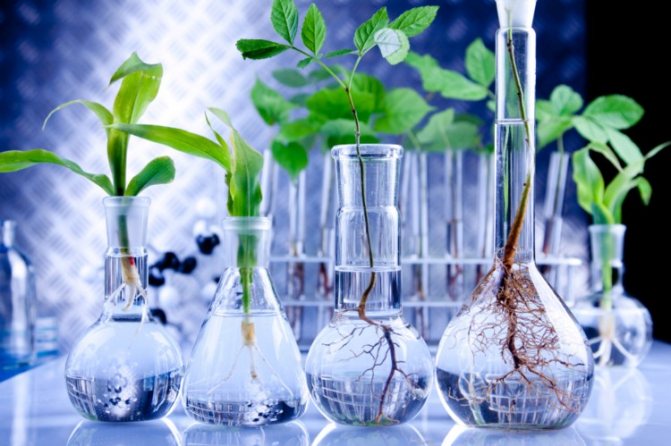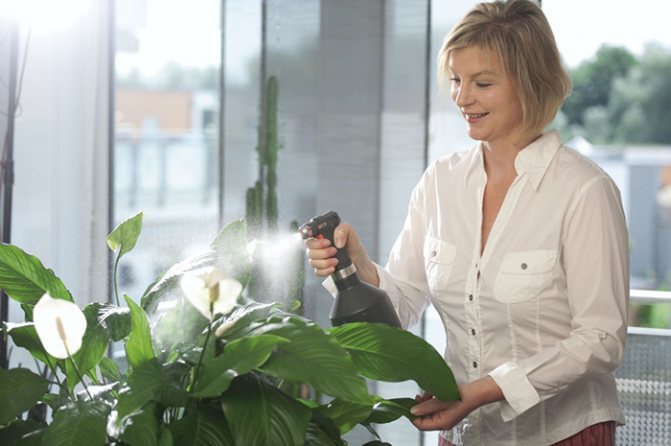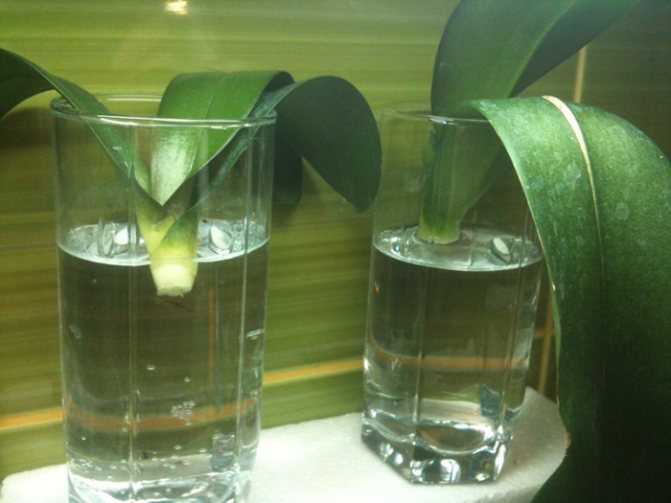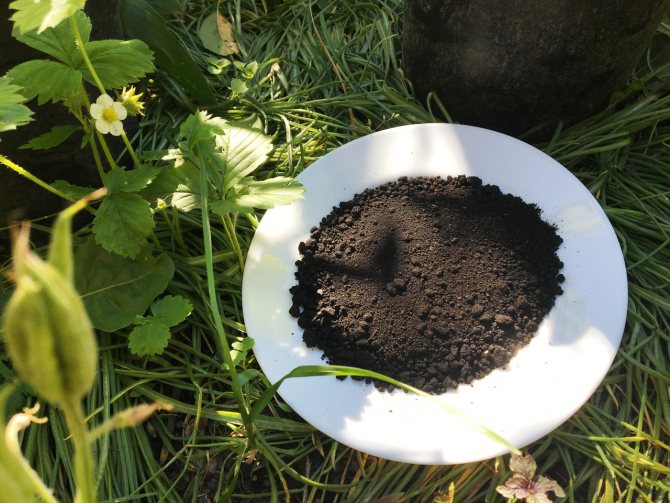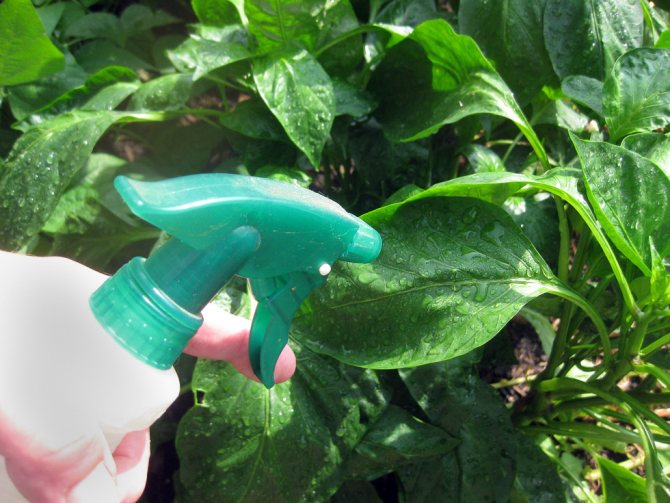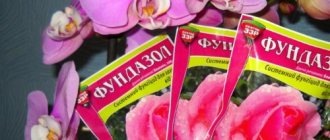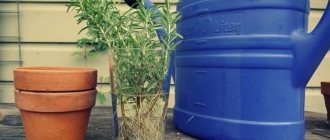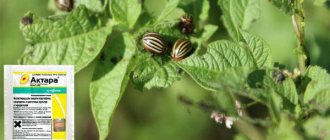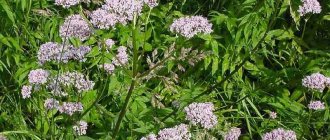Florists relatively recently began to use succinic acid for flowers. The tablets of this water-soluble organic compound quickly gained popularity due to their effectiveness and low cost. Due to the ease of use, everyone can feed flowers with succinic acid.
Characteristics and composition
Succinic acid is not sold in grocery stores. It is purchased at the pharmacy. The release form is different, but the chemical name is the same - butadiene acid.
The substance is used in practice as a dosage form to restore the immune and nervous systems, filling them with energy. Has various fields of application. Doctors recommend using it for:
- improving the functioning of the brain;
- to increase attention and concentration;
- enhancement of reflexes;
- relieving stress from the body and nervous system.
The formula of succinic acid is designed in such a way as to relieve inflammation and prevent the appearance of neoplasms, restore blood circulation and veins.
Like this, amber helps plants regenerate. Impregnation of the immune system occurs, which means that photosynthesis is improved. It will help improve the condition of not only indoor plants, but also in the country.
Succinic acid is not a chemical, but organic. Found in cheeses, gooseberries, and grapes. Sauerkraut has become a storehouse of this substance. Naturally, amber itself is the main starting material for the acid.
Modern science manages to obtain the composition of succinic acid according to the formula from n-butane and benzene. Due to the combination of the two components, crystals are obtained, and then they are ground into powder (white color). Taste: sour taste. In this case, the crystals dissolve well in water.
The auxiliary components are:
- potato starch and talc;
- aerosil and sugar;
- ascorbic acid and calcium stearate.
Reviews on the use of succinic acid
Oksana: “I use amber for my flowers not only in the room, but also outside. Especially good for my flowers in outdoor pots. They often have problems with a lack of minerals in the soil. Also, their roots are rather cramped, which affects the condition of the entire flower. To improve the look, I water it with acid only once a month. "
Irina: “I use the drug during the transplant period. With the solution, I water the very ground into which I will transplant. After watering, I let the substrate brew for several days and only then I plant flowers there. I noticed that after such a procedure the condition of my flowers improves significantly, and after transplanting they adapt faster. "
Alyona: “Recently, a friend gave me stunted cuttings of ageratums, which I wanted to plant at my place. To normalize their condition, I left them soaking in a solution of several tablets and water for 5 hours. After that, I calmly planted them on a flower bed and ageratums began safely and grow violently. "
Marina: “I use the drug only in combination with fertilizers for better growth of indoor plants. The acid itself will not give such a colossal effect and will not replace fertilizers.I water the flowers with a mixture of acid during the period of active growth so that the flowering is abundant and long-lasting. "
Fertilizer properties
The chemical properties of amber are unambiguously beneficial for the treatment of human ailments. In practice, the medication began to bring positive reviews in gardening, with the reproduction of indoor plants.
Succinic acid for plants becomes a growth stimulant. Purchased in the form of tablets or injectable liquid, diluted in water, it is used for spraying or watering. The following are the positive aspects of processing:
| Benefit | Specificity |
| Sustainability | A plant treated with acid, even in small quantities, is not afraid of frost, moisture or drought. Gains increased resilience and protection |
| Root formation | If necessary, replanting the plant and arresting the roots becomes an indispensable tool. Helps resuscitate, propagate and transplant without problems |
| Chlorophyll | This substance is produced doubly. Due to this, flowers and garden crops acquire an improved color and are filled with vitality. |
| Stimulant | When plants are treated with amber, an improved work of the root system occurs, which absorbs the added bioadditives from the soil faster. Growth is accelerated and appearance is improved |
| Destruction of toxins | Toxins and other negative substances always accumulate in the soil. But when treated with succinic acid, toxic elements dissolve |
| Increased adaptability | If the flower is sick, then it is simply necessary to use amber. It will help the plant's immunity to protect itself from negative bacteria, microbes, fungi. In addition, he will recover faster after an illness. |
| Microflora | After processing, the activity of positively charged particles is balanced, which clearly improves the quality of the soil microflora |
Indications and application of succinic acid tablets
The drug in tablets can be found in pharmacies, but you should not buy and use dietary supplements with its content, since they are intended only for people. Prolonged adaptation and deterioration of appearance - these factors can be called key indications for the use of the substance, reviews of florists confirm the effectiveness of the stimulant in such cases.
For rooting
For rooting, special stimulants are used, however, as a rule, they are too strong and can harm a weak flower, therefore, succinic acid is more often used.
This substance is often used for rooting cuttings, which have formed tissues, the growth of which will stimulate the drug. In most cases, a plant shoot is selected for reproduction, on which there are already several leaves.

Rooting in succinic acid
To speed up the process, you need to prepare a solution in which the concentration of the drug will be 1%. To do this, add 1 liter of filtered water to 10 grams of the substance, mix thoroughly. If it is necessary to prepare a solution from tablets, then take 2 pieces. A larger amount of the substance will not give the best result, but it can destroy the cuttings.


You may be interested in:
Fitoverm for indoor plants - how to breed and use? Fitoverm is a biological product that has established itself as an affordable and easy-to-use insect repellent. He ... Read more ...
For soaking, choose a long, deep container, such as a food container. A solution is poured into it to a level of 3-4 centimeters. In a sheet of hard cardboard, holes are made for the stems with a knife or scissors. A handle is inserted into each hole. The prepared shoots are placed in a container with the cut end, immersing the stem a few centimeters.
The cuttings are allowed to stand in the solution for 24 hours. The container is not completely covered with a lid to allow air access.If the stalk is very fragile, wrap its end with a cotton swab and only then immerse it in the solution. For such appendages, the hole in the cardboard must be made larger. A day later, the flower is rooted using the method adopted for this variety.
After transplant
Most indoor plants need replanting. In this case, the flower is taken out of the pot, its root system is cleaned of the substrate, carefully examined for damage or disease. If necessary, the damaged areas are removed. In this case, it is advisable to use amber.
Remember!
Such a procedure will not only help the flower to endure the transplant well, but also restore its strength in case of an illness.
For this, a solution is prepared from 1 tablet, or 10 grams of the substance, and 1 liter of water. Experts recommend giving preference to the powder form of the drug. The roots are soaked in the resulting solution for 30 minutes. Then the flower can be planted in the prepared new soil.
Care should be taken to transplant amaryllis, hippeastrum, clivia and krinum. The root system of these plants is firmly fixed on the side walls of the pot, and in order to transplant them, it is necessary to break or break the container. To process the roots of such plants, a solution is prepared from half a tablet and 1 liter of water. The flower roots are immersed in the mixture for 30 minutes.
For survival
Treating a young plant with a solution will help speed up its survival in a new pot. To do this, you need to prepare a solution from a quarter of a tablet and 1 liter of water. The plant is soaked in such a solution before planting in a new pot for 1 hour.
A young plant is immersed in a container so that it does not reach the bottom of 1 cm. You can also water a flower well with such a solution when it is still in a temporary pot. In this case, the flower must be allowed to stand for several hours and then proceed with its transplant. It is necessary to transplant the flower after acid treatment as soon as possible, since the effect of its use may be lost.
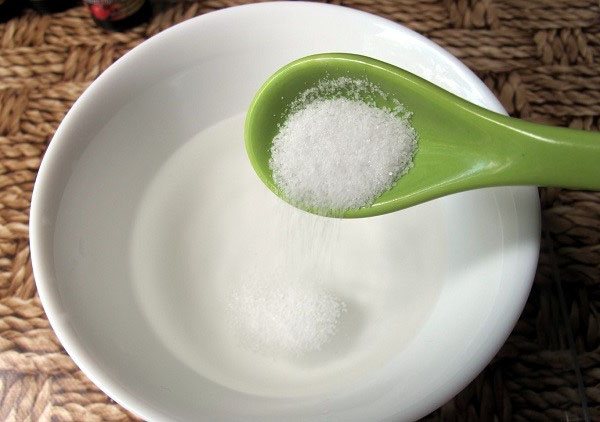

To do this, choose a shallow container, into which the solution is poured to a level of 4 cm.
Against stress
Stressful situations for plants are transplanting, transporting, changing the place of the pot, low temperatures, drying out, over-watering, diseases, parasites, as well as improper care. Signs of stress in plants are:
- sluggish stems that have lost their elasticity;
- leaves that have become less saturated in color and have lost turgor;
- prolonged absence of flowering.
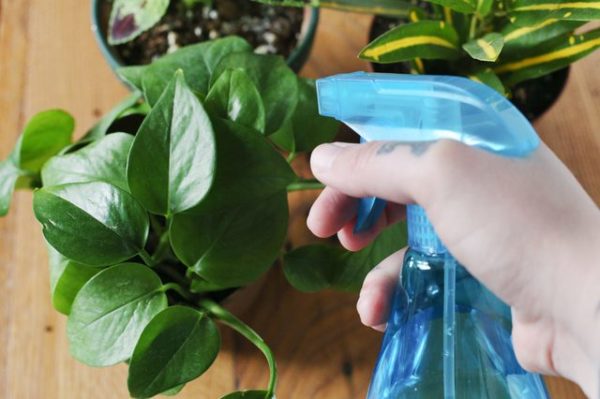

Also, the drug is used for epiphytic plants that grow in soil that is not saturated with macronutrients and minerals. In such cases, the acid's property helps to stabilize and enrich the flora of the substrate.
To prepare the solution, it is necessary to pour half of the acid tablet with 1 liter of warm water. The resulting mixture is thoroughly mixed and poured into a spray bottle with a fine nozzle. The flower is sprayed once every 14 days until complete recovery.
Pros and cons of using
The action of the acid on the plant is more like a growth stimulant. At the same time, the use of a medication as a fertilizer has additional advantages:
- It stabilizes the soil microflora, contributes to the resistance of the plant to diseases.
- The stimulating effect of succinic acid does not end there. The growth stimulator increases the immunity of the plant, prevents fungal and bacterial infections from damaging green spaces.
- Reduces stress factors: pressure surges, temperature problems, drought or high humidity, lack of lighting.
Indoor flowers suffer most from stressful situations. The soil in pots changes and is associated with human actions that are unpleasant for the plant. The roots are always damaged, and when transplanted, they are exposed.
It is difficult to survive so much at one time.The plant undergoes special tests during periods of drought or rainy weeks. Indoor “green dwellers”, humidity and dryness of the air also greatly interferes with growing and looking healthy.


The benefits and harms of succinic acid in the analysis are huge of the negative points: an increase in the dose leads to unpleasant consequences. The plant should not be over-fertilized. But if it is necessary to fight chlorophyll, succinic acid becomes an emergency aid.
Useful properties of the substance
The acid is formed as a result of processing amber and has the form of transparent or white crystals. The product can be used to feed almost all types of plants that grow in indoor conditions.
The substance is found in many cultures and is even produced by the human body. It helps the body cope with stress and excessive physical exertion. Plants also need support during illness and stressful situations.
Acid is proven to be essential for crops. During the growth period and under adverse conditions, it is quickly consumed. Therefore, to maintain tone and resist pathogenic factors, it is recommended to introduce additional doses of the drug. It is believed that the most effective early treatment of a young plant during the period of active development.
The substance is not a fertilizer, but belongs to the number of useful additives. Thus, it is almost impossible for them to harm indoor plants.... Useful properties include:
- Protection against adverse external factors, temperature extremes, dry air, high humidity and other negative phenomena.
- Strengthening the immunity of crops, improving the protective functions that help resist diseases and pests.
- Destruction of harmful bacteria and microbes in the soil and, thereby, improving its composition. Removal of pesticides and heavy metals from soil.
- Natural stimulation of metabolic processes inside plants, which leads to their enhanced growth.
- Contributing to better assimilation of fertilizers, increasing the amount of chlorophyll in leaf plates.
- Help in quick recovery from disease and pest damage.
How to make a compost pit with your own hands
Release form and production features
Butadiene acid is sold in drugstores as a medicine. Amber water is prepared independently at home on the basis of a purchased pharmaceutical preparation.
It is sold as an injectable liquid in ampoules, tablets or powder form. All forms that are available commercially are suitable as fertilizers.
Tablets are amber or in powder, but succinic acid is compacted, dry. It dissolves perfectly in water, which allows you to quickly prepare a liquid for feeding. The ampoule remedy is popular. Since it is enough to add it to water and stir for less than a minute. Everything. The product is ready without much effort.
Regardless of the type (tablets, ampoules, powder), the composition is the same, only the dosage of the main components is slightly changed. Therefore, before starting watering, it is necessary to clarify the recipe and the method of diluting the drug.


Top dressing and resuscitation of indoor flowers with succinic acid
Florists have a mixed opinion about the use of succinic acid. Some people cannot imagine caring for plants without her, others prefer traditional methods. But most orchid lovers use the drug as a growth stimulant, resuscitation agent and for root decay.
Use of succinic acid for orchids
When rotting on the roots or trunk of an orchid, you need to clean it up to living tissue and remove all affected areas by treating the sections with a fungicide. To stimulate the growth of new roots, the orchid can be fed on a leaf and cotton pads can be applied to the trunk with a mixture of a concentrated solution of succinic acid (2 tablets per 0.5 l of water) and a complex of B vitamins diluted in 1 liter of water.
Florists recommend using the same recipe when wrinkling leaves, for growing children on peduncles. Some liquid complex fertilizers, which are preferred by orchid lovers, already contain succinic acid, but its amount is not always indicated.Florists who are involved in violets, azaleas and gardenias also use this remedy as a growth and flowering stimulant.
The effect of using succinic acid is not noticeable to all plant breeders. After a single treatment of the plant, lovers of indoor flowers expect some wonderful result and are disappointed in the preparation if nothing happens. But most still see its positive effect: an increase in the number of buds or the appearance of a rich color in the leaves. It manifests itself best on young plants. Sometimes positive changes become evident only after the second or third treatment with succinic acid.
The effect of fertilization on soil and plants
Amber fertilizer is an excellent tool for killing bacteria and restoring the plant with the necessary microelements. Acid is suitable in different situations that arise in the country or in the garden, in the apartment.
If the effect on domestic plants of succinic acid is quite clear - stress relief, restoration of immunity.
That begs the question of whether it can be used as a top dressing for cucumbers, tomatoes or other vegetable crops? To understand this, it is worth studying in detail for what and how you can use the drug.
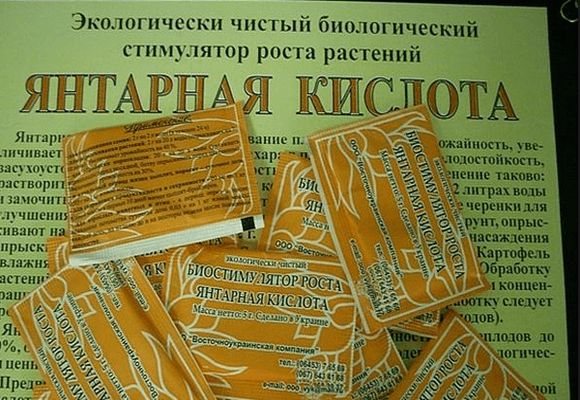

It is suggested to use amber water from the stage of plant development: seeds. Processing is carried out before direct sowing. To do this, prepare a 0.2% solution (dissolve 2 mg or one tablet in 1 liter of water), soak the seeds.
Proper watering of the orchid
Since in nature orchids feed on rainwater, at home it must be watered with soft water (you can use melt water, this option is closer to rainwater). If you are using tap water, it is best to first settle the water for 24 hours. We do not recommend using purchased purified water, because this water is dead and there are no nutrients in it.
Since in nature, orchids periodically dry out without rain, and at the same time feel comfortable, there is such a rule, it is better to underfill than to pour. Due to strong watering, the roots of the orchid can rot. Sometimes, to speed up the drying process of the orchid, additional holes are made in the pots on the side. After the orchid blooms, in the dormant stage, the orchid is moistened only slightly. Another nuance when watering this flower is that watering also depends on the type of orchid. For example, Cattleya and Dendrobium just need to "dry out" from one watering to another. And the phalaenopsis in the pot should always be slightly damp. In summer, the orchid is usually watered every 4 days, in winter once a week.
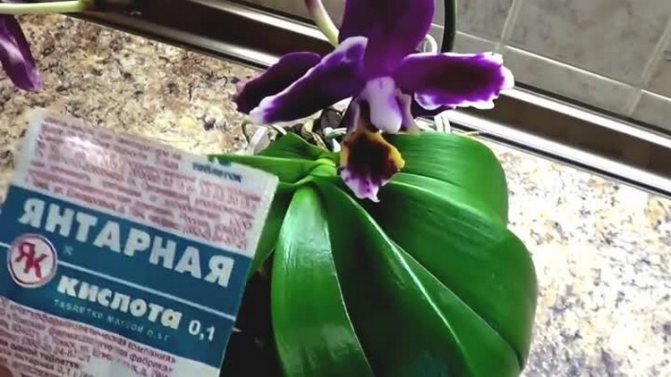

When using succinic acid, it should be remembered that it has an auxiliary effect. The solution is not a panacea and cannot replace other feeding and care procedures necessary for the orchid. However, it perfectly improves the absorption of nutrients, and also stimulates the development of flowers and plant recovery after the influence of stress factors.
loading ...
Application features for indoor plants
Home floriculture is much more difficult than it first seems. In an apartment, where there is less fresh air, there are much more stressful situations for plants.
The destruction of bacteria, fungus and other diseases is more difficult. To strengthen the immunity of the indoor "inhabitant", it is the amber liquid that is recommended to accelerate the growing season.


For indoor flowers, succinic acid is especially necessary when overheating or excessive humidity is present. It is always difficult to find a top dressing, fertilizer for the "gentle creatures of the windowsill". But amber compensates for the lack of vitamins and nutrients in the soil.
If a person is a happy owner of tropical plants (for example, orchids), it is worth remembering the need for a special attitude and care for flowers.Feeding orchids with succinic acid will help to improve health and activate photosynthesis. It will also stimulate the formation of peduncles.


This plant often suffers from root rot. Productive treatment, stress relief can be done with a weak solution. To do this, you need to dilute the orchid tablet in 5 liters of warm water.
This solution is recommended for frequent use. Spray once every 21 days. As soon as the product is running out, the leftovers are poured into the soil. Systematic application helps to protect orchids from diseases, rot and other negative aspects.
If the florist is fond of roses, the use of acid is like street pink beauties. The only thing worth remembering: rose flower beds at home are softer. Spraying is allowed once a month, and application to the ground is allowed once every 2 months.
Chemical properties of succinic acid and benefits for indoor plants
This substance is regularly produced in the body of the plant and acts as a biological stimulant. Lack of acid can lead to inhibition of growth and delayed flowering.
The substance has a beneficial effect on the microflora of the substrate and has a beneficial effect on the vital activity of the bacteria living in it. The acid promotes the rapid growth and development of flowers during the flowering period, therefore it is also used as a flowering stimulant. The substance helps the plant adapt faster after transplanting, get used to changing its placement, and also recover from illness or long-term transportation.


Acid properties
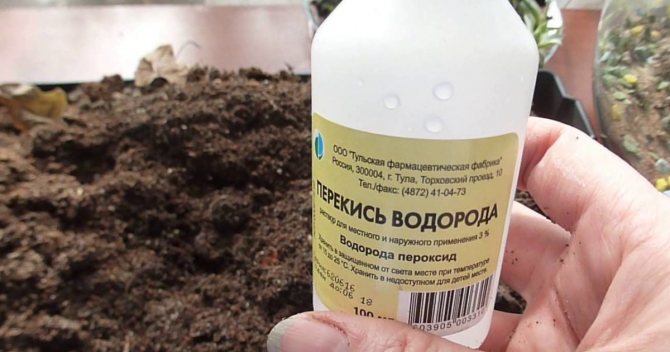

You may be interested in:
Hydrogen peroxide for indoor plants - watering application and dosage Many have heard about the benefits of hydrogen peroxide for the human body and its use in first aid for ... Read more ...
The main chemical properties of acid include the ability to influence the synthesis and release of chlorophyll in leaves. The leaves become elastic, acquire a brighter color. Due to the chemical properties of the substance, it is possible to increase the plant's resistance to such harmful factors as drying out of the soil, exposure to direct sunlight or excessive soil moisture.
It is it that will help protect the root system from rotting, and the leaves from yellowing and drying. In cases of propagation by cuttings, the drug can be used for rooting and accelerating the growth of the root system in young plants. Also, the drug is used when treating seeds to increase germination.
Good to know!
The substance promotes rapid binding and elimination of toxins, being an antioxidant. Acid minimizes the harmful effects of nitrogenous substances, and acts as an antihypoxant, contributing to the saturation of the plant with oxygen.
Acid is most effective in combination with fertilizers, since it is not a substitute for them. For plants, "amber" is used in the form of powder or tablets, which are dissolved in water.
Work instructions
Instructions for the use of succinic acid for plants are not prescribed. And it is impossible to see her in a box with pills or powder. The standard dilution is to add 0.1 g of powder (tablet) to warm water.
In tablet form, it can be 0.25 g. In this case, you must add 4 tablets at once. The moment of direct application is taken into account: to improve flowering, as a flower dressing or as a medicine.
Dosage
The dosage of succinic acid depends on the direction of application. But the remedy has an effect even at low doses. Weak solutions are prepared at the rate of 1 tablet per 1 liter. Suitable for wiping the green part to improve photosynthesis, for the treatment of sensitive plants.
Soaking orchid roots in succinic acid
Shown at:
- prolonged stress;
- a sharp change in growth conditions;
- transplant.
For this, the pot is placed in a nutrient solution for 5-10 minutes.
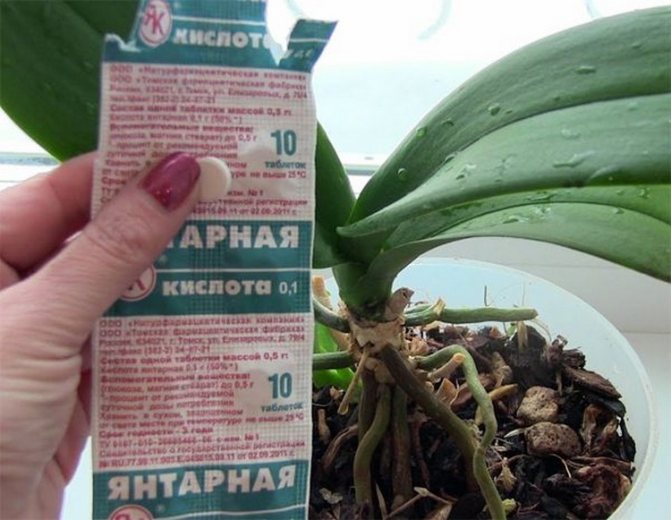

When an orchid is transplanted, they act differently:
- cleanse the roots of excess soil;
- kept in acid for about half an hour;
- drying the plant in the open air;
- placed in a disinfected substrate.
Plant processing methods
It is recommended to use the amber liquid in several ways. They are also suitable for floriculture and horticulture. More often than other methods are watering and spraying. But amber will also be useful for:
- wiping the green part;
- soaking the roots before planting or between the process of transplanting into another pot.
Soak
Succinic acid for seeds, seedlings, cuttings, tubers, root system is prepared in low concentration. If you need a quick result, the solution is mixed for 2 days at the rate of 0.4 g per 1 liter.
No matter how soaking occurs, after it the planting material is dried and then planted in the soil... If germination began during soaking, planting occurs immediately.
In the garden, succinic acid has the same application as in floriculture.
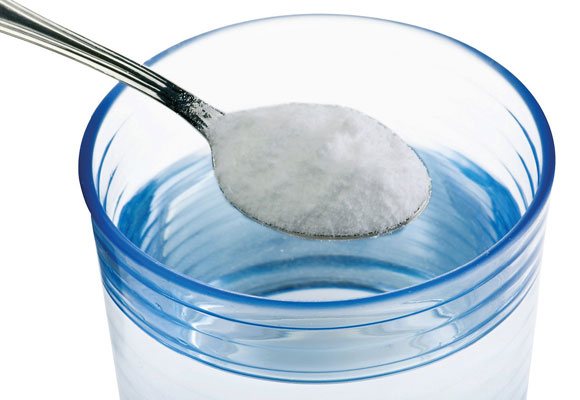

Spraying
The use of succinic acid for seedlings makes it possible to fill a young plant with energy, strengthen the immune system. The spray liquid works as a growth stimulant for plants.
The use of the method involves processing with biomaterial in the morning or after sunset. Do not allow sunlight to enter during spraying, as you can burn leaves, stems and shoots.
The procedure is done either with a weak solution (the flower is healthy, but requires a little life-giving moisture), or the solution is mixed with 0.03%. The exception was grapes. The vine is treated with 0.08% succinic acid solution.
Watering
Watering flowers with succinic acid in horticulture and floriculture is a restorative procedure. A standard mixture is used: 1: 1 powder and water. Carry out the procedure, both in the country and in the apartment, no more than once every three weeks. To achieve the best effect, it is recommended to combine watering and spraying, but with different solutions.
Ways to use for flowers
The most convenient and easiest method to use is watering your houseplant. The tool is an excellent growth stimulant, which also has healing properties. Often it is not recommended to fertilize the soil with a water composition, it will be enough once every 2-3 weeks.
Composition and instructions for the use of nitrophoska fertilizer
Spraying with solution
The active substance can be quickly delivered to the tissue of the culture by spraying the leaves. The aqueous composition is absorbed almost instantly through the stomata, which are located on the lower part of the leaf plate. Therefore, it is better to spray with acid in such cases:
- in early spring to activate vegetation and withdrawal from "hibernation";
- after pruning to eliminate stress and awaken the kidneys;
- after exposure to insecticides or fungicides to reduce their toxicity;
- after the elimination of pests and diseases, a long stay in negative conditions.
The acid dissolves well in water, but some undissolved grains can clog the spray bottle. A filtered solution should be used.
You need to process a houseplant in the morning or evening, when there is no sun rays. Spraying is not carried out during the flowering period.
Application for roots
The substance is a mild root-forming agent. They are good at restoring and maintaining the root system when transplanting plants. In more serious cases, it is better to give preference to stronger drugs. For example, poorly cuttings are rooted using "Kornevina" or "Heteroauxin".
Rhizome processing is carried out in two ways - through watering or soaking. Watering is done after planting in a new pot. Roots are soaked in a convenient container for 3-4 hours.
Seed treatment before sowing
Indoor flowers are rarely bred through sowing seeds. This is a time consuming and complicated method, as a rule, poor germination is observed. In such situations, the use of growth stimulants is very justified.
The seeds are treated with acid by soaking. There are two ways to do this:
- Cotton pads are impregnated with a solution, the seeds are laid on them, covered with the same discs and polyethylene on top, and kept until the first shoots appear.
- The planting material is placed in a glass, poured with the composition and left for 1-2 hours (systematically stirring), then dried to a state of flowability.
What fertilizers are best for indoor plants
Seeds treated in the first way are carefully freed from the discs and planted in the ground. Planting material subjected to the second method should be sown immediately.
It is very important to understand that some colors will require a lower concentration. The volume is determined taking into account the size of the pot and the individual characteristics of the plant. At home, it is allowed to combine several types of processing at the same time. For example, watering and spraying.
Precautions
In practice, it has been proven that an overdose is not harmful. Succinic acid is present in 65% of plants. But it is worth diluting the biomaterial according to the instructions. Especially when it comes to irrigation. A strong solution can cause a burn on the green part.
For humans, animals, amber is not toxic or harmful. Therefore, any manipulations can be carried out without gloves or a respirator. It is worth remembering to avoid getting acid on the mucous membrane. An acidic environment promotes inflammation and vision problems.


How succinic acid is obtained - its reserves in nature
Butanedium or succinic are varieties of carboxylic acids that are isolated from natural deposits - hardened tar, brown coal. That is - the substance is completely natural and safe for living organisms.
Mineral deposits are found all over the world - mainly these deposits are the dried bottom of prehistoric seas. In the Dominican Republic, there are even deposits of blue and green amber, which are very rare - they are equated with precious stones, especially if inside they have ancient insects and reptiles that inhabited the planet millions of years ago.
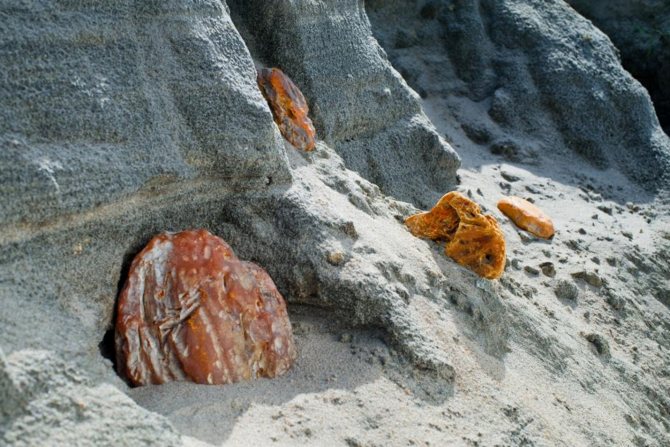

Stones are mined by quarry or by hand. Those specimens that are not suitable for jewelry are used for medical purposes, as well as in the electronic, food and chemical industries.
The second method is extraction from brown coal. The third is the hydrogenation of maleic anhydride. This is the cheapest and technologically simplest way to release succinic acid as a fertilizer for indoor flowers and to maintain metabolism - for plants, the instructions for use are somewhat different than for ingestion. It is recommended that you familiarize yourself in order to properly prepare the solution.
How often and how much should you fertilize?
Succinic acid is not a fertilizer. Therefore, it does not replace top dressing. It is brought in to stimulate and heal:
- for the general strengthening of flowers - once a month in the summer;
- maximum twice in all cold months;
- once every 7-10 days in the treatment and restoration of weakened flowers.
You can not constantly use the substance. The plant must independently produce it in the right amount. The constant introduction of a biostimulant will disrupt the natural synthesis process.


How to use succinic acid in crop production correctly?
A solution of succinic acid is prepared from powder or tablets.
The drug is sold mainly in pharmacies. You can also order it online through the online store. The cost is, in principle, affordable for any gardener. So 50 grams of the substance will cost from 7 to 50 rubles. Much depends on the manufacturer of the drug, the dose.
Composition and preparation of the solution
One tablet usually contains 0.1 gram of the active ingredient. For soaking cuttings or watering, the tablet or powder form is turned into a liquid. Let's consider how to make succinic acid at home. Dissolve 10 tablets in a glass of water and then bring the volume of liquid to a liter. It turns out a 0.1% solution. If a weaker concentration is needed, add more water. It should be borne in mind that for each specific case, a certain dosage is required.
Methods of using the drug
It is important to choose the right way of processing a garden plant or flower. After all, a variety of methods are known. Consider the most common of them among domestic florists.
The main options for how succinic acid can be used for indoor plants are given below:
- Spraying the part above the ground. To do this, make a 0.01% solution. Treatment helps to avoid various ailments, and is also an excellent prophylaxis against parasites. But with a weaker solution, flowers are treated, they increase their cold resistance and resistance to hot climates. It is forbidden to spray during the flowering phase. And so the procedure is carried out every 3 weeks in order to accelerate branching, the formation of peduncles and buds. Achieve in a similar way and longer flowering. The procedure is carried out in the evening or early in the morning.
- Soaking roots, seeds, cuttings. A weakly concentrated solution is suitable for this purpose - 0.004%. It is important to thoroughly dry the seeds and cuttings before planting.
- Rubbing leaves, shoots and trunks. This method is usually used when attacking insect pests. After a week of treatment, all parasites should disappear. If this does not happen, then other, stronger means are required.
- Irrigation. A highly concentrated solution is suitable for this. There is no need to remove excess from the leaves. Such feeding with succinic acid to microorganisms living in the substrate will be very useful. Usually watered once a year. And crops such as succulents and cacti are irrigated just once in their entire life cycle. As a result of such treatment, the microflora of the soil is normalized, toxins and salts of heavy metals are removed. In addition, it is an excellent prevention of fungal diseases.
How to use succinic acid for indoor plants, including citrus fruits, and horticultural crops in different cases, is given below:
- To strengthen the root zone, the formation of additional roots. The root system is soaked in a 0.02% solution for 1-2 hours. Or they simply spray from a special device - a spray bottle.
- Germination of cuttings. Assumes the use of succinic acid of 0.002% concentration. The cuttings are lowered to a depth of 2 centimeters for about a day.
- Growth stimulation. For this, the aerial part is sprayed every two weeks. Before pouring with succinic acid, you should decide on the most suitable timing. It is allowed to process the crop before and after flowering.
- Resuscitation. Water the entire ground part. The solution is prepared as follows: the tablet is dissolved in a liter of water. If powder is available, 0.5 grams will be needed.
- Increased seed germination. For this purpose, the treatment with succinic acid is carried out in this way. For a day or half a day, the inoculum is soaked in a 0.004% solution.
Features of use for orchids
Knowing how to use succinic acid for plants can have a beneficial effect on their growth and development.
The most difficult flower to grow is orchids. But with succinic acid it is possible to overcome many problems and difficulties.
But for this it is important to understand how to dilute succinic acid correctly. Usually, one tablet or powder of the drug (it is taken approximately at the tip of a knife) is dissolved in 0.5 liters of water. For spraying, a spray bottle is used. Roots and lower leaves are processed.If the mixture remains, it is allowed to use it for watering the orchid. As a result, there is a great chance to revive a sick and damaged flower, to start growth processes.
Here's how to use succinic acid to intensively form a strong root zone: soak the roots in the prepared mixture for a period of half an hour to several hours. It is important to note that flower growers have different attitude to amber acid. Some are sure that it is very useful, and knowing how to fertilize indoor plants with succinic acid, there is every chance of getting a healthy and beautifully blooming culture. Others prefer more traditional grooming methods. However, many people use this substance for orchids, because it stimulates flower growth well. Check out the article: Why Use Orchid Cytokinin Paste?
How to breed?
Before use, it is necessary to make a weak aqueous solution of the biostimulant. To do this, do the following:
- The required amount of the drug or tablets is measured.
- Dissolve the stimulant in a small volume of warm water.
- Add liquid to the required amount.
The biostimulator is ready for use.
Proportions
The ratio of water and drug for preparing a solution depends on the purpose. To enhance growth, strengthen, improve vegetation and other purposes, do the following:
- flowers are watered with a solution: 1.5 ml / 1.5 g per liter of water;
- sprayed - 1 ml (1 g) per liter;
- soak - 0.5-1 ml (0.5-1 g) per liter for rooting.
The proportions are indicated for the active ingredient. It should be calculated in advance how many tablets or solution will be needed. For example, one tablet of pharmaceutical Amber contains 0.5 g of succinic acid. This means that you need to dissolve three for watering, and one tablet is enough for soaking.


During the rest period, it is better not to use a stimulant or use a very weak solution of 0.05 ml (1 gram of active ingredient) for prevention. For treatment, transplantation, rooting, use the usual proportions when processing.
How long before watering to dilute?
Before using succinic acid, you need to prepare a solution:
- the drug in tablets and powder is dissolved several hours before processing, so that the microcrystals of the substance are completely dissolved;
- mixture with liquid concentrate can be used immediately after preparation;
- you can prepare the solution 2-3 days before use. It retains its properties for at least 72 hours. Then the active substance begins to break down.
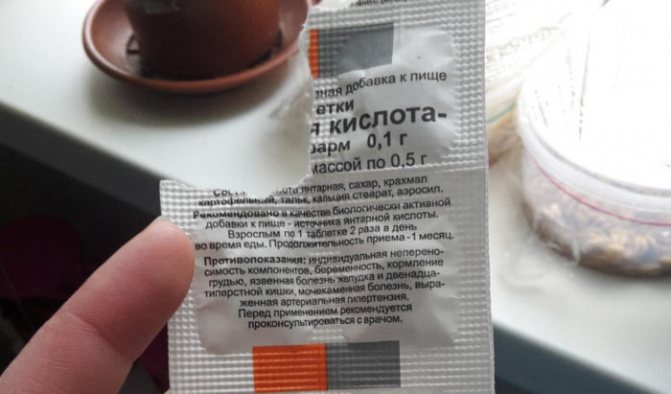

Shake the prepared mixture thoroughly before use.
Important. Succinic acid is often used to stimulate the appearance of babies. But when growing succulents, it is better to refuse this method. Flowers will begin to produce a large number of offspring, which will lead to the depletion of the plant.
Potential harm
In nature, succinic acid is found not only in amber. Small amounts of this substance are found in the tissues of all plants. Therefore, you can consider it as a "native" component for them, and not be afraid of any side effects.


Experiments with the use of solutions of succinic acid of different concentrations on indoor plants have shown that even a small overdose does not cause any noticeable harm. Plants tolerate well an uncritical increase in the strength of the solution when watering or soaking. Leaves may be more sensitive, especially when sprayed on sunny windowsills.
In general, succinic acid can be considered completely harmless to indoor plants. The main thing is to follow the processing rules and adhere to the recommended dosages.
Feedback on the use of acid for plants
Reviews of gardeners who used succinic acid to stimulate growth or strengthen plants are often positive. The most important thing is that the plant increases its resistance to diseases by strengthening its own immunity.
Gardeners note that the biostimulant is not able to completely protect plants from diseases or parasites, but when used correctly, it effectively helps to increase resistance. A strong immunity is a healthy plant with abundant flowering and high yields.
To achieve the desired result, it is necessary to adhere to the recommendations of specialists and strictly observe the recommended dosage.
Act
Chemical formula of succinic acid
In respectable trade avenues, Yantarin is positioned as a plant stimulant; sometimes - as a growth promoter, which is also true to some extent. But succinic acid (the formula in the figure on the right) is not an auxin-like compound and not a phytohormone at all. Its stimulating effect is of a different nature.
The vital activity of all living organisms is provided by special substances, the so-called. macroergic (energy-intensive) - energy storage and transporters. Macroergic compounds of living things are known approx. 40. Of these, the most important is adenosine triphosphoric acid (ATP); the role of guanosine triphosphate (GTP) is also essential.
Macroergic substances are formed in organisms in three jointly acting ways:
- In the respiratory chains;
- Oxidative phosphorylation;
- On the so-called. the general path of catabolism.
The general pathway of catabolism provides, in addition to directly energy carriers, substrate substances for mitochondrial respiration. In plants as producer organisms, the role of the general pathway of catabolism is especially important. The central phase of this biochemical process is the so-called. the tricarboxylic acid cycle, or the Krebs cycle (by the name of one of the discoverers), or, not quite correctly, the citric acid cycle.
Note: Hans Krebs and Fritz-Albert Lipmann were awarded the 1953 Nobel Prize in Chemistry for their research on the general pathway of catabolism.
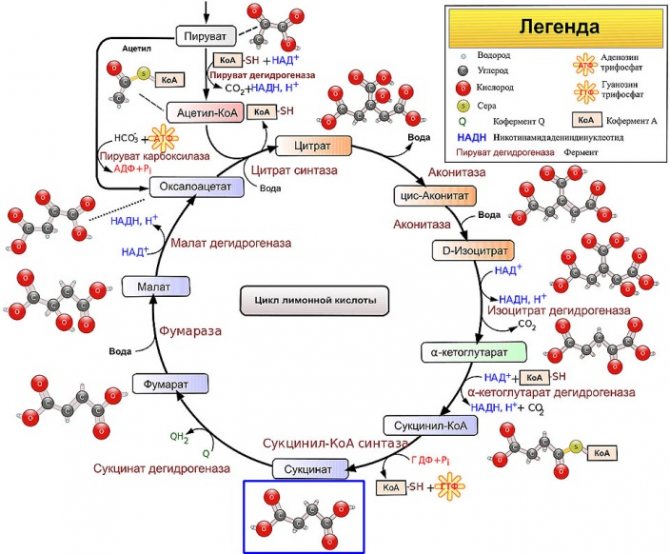

Scheme of the tricarboxylic acid cycle on the general pathway of catabolism
Succinic acid is one of the links in the tricarboxylic acid cycle (shown in the blue box in the figure on the right), but the link is critical. Due to its relatively low molecular weight and simple chemical structure, the hydroxyl groups of succinic acid are chemically very active. But for the same reasons, succinic acid easily decomposes in light and air, or is lost by plants by simple diffusion. The plant organism has to spend a good share of the energy it receives from light and nutrients to replenish its "unplanned" loss.
Feeding plants with succinic acid releases this energy to activate life processes. Let's imagine, figuratively speaking, a goner smoked to the ends of his hair. And so, a certain pill appeared in pharmacies, the reception of which clears his lungs to rosy ones, like a sturdy baby. The effect of succinic acid on plants is somewhat similar to the effect of such a hypothetical drug.
And the mushrooms?
In some manuals and product descriptions, succinic acid is attributed to the properties of a fungicide or, in general, a universal pesticide. This is not true. Plant cells on top of the cell membrane are covered with an outer cellulose membrane - succinic acid diffuses through it. Animal cells are deprived of a special protective shell - they are protected by the outer covers of the body, which provides animals with mobility. But the cells of the fungi are covered over the membranes with a continuous layer of chitin. For succinic acid, the thinnest chitinous layer is impermeable, therefore, it does not act on fungi by contact and is not absorbed by hyphae. The correlation between the use of succinic acid in plants and the degree of their susceptibility to phytopathogens and pests is false, because the increased resistance of plants in this case is simply due to the stimulation of their vital activity by the preparation.
Effects on plants
The use of succinic acid for plants provides a number of positive effects:
- The product stimulates good flower growth.Its action improves the quality of absorption of nutrients from the soil, helps to survive in an aggressive environment and stressful conditions.
- Succinic acid for flowers normalizes the quality and interaction of microorganisms in the soil where the flowers grow.
- The product has no harmful effect on the environment, no special disposal is required.
- Plants can be fed with this acid for different purposes. Watering flowers with a solution activates root formation, accelerates the growth of the green part of plants.
- Knowing how to water flowers with succinic acid, you can always help plants restore the disturbed processes of their vital activity.
- Treatment of cuttings and seeds with the preparation increases their germination.
- This natural component is effective even in very low concentrations.
- The product is completely harmless to people, vegetation and animals, since it is completely absorbed by the soil microflora.
Despite a fairly large number of useful properties, this tool cannot replace conventional fertilizers. How to water flowers with succinic acid, we will consider later in the article.
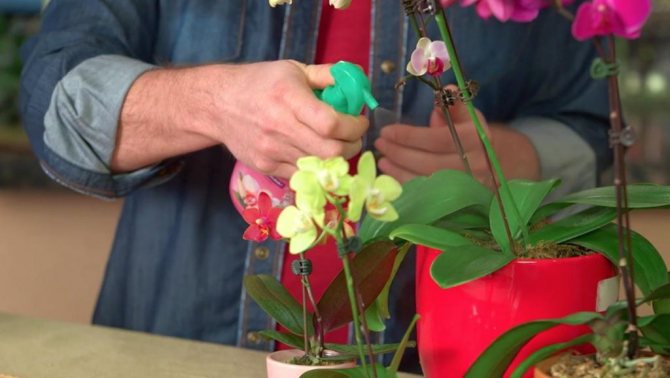

The degree of danger
Yantarin is classified according to hazard class 3 for humans and hazard class 3B for bees. However, this is what shows (on the contrary) how conventional the hazard classifiers are and how important it is when working with a drug to pay attention to the specific properties of its active ingredients (AD).
In the 3rd grade for humans, Yantarin ended up, in essence, because the deliberate misuse of the drug or extremely careless handling of it can cause severe poisoning. Which is not excluded, tk. Amber is intended for use by unskilled users in private household plots. However, the toxicological indicators of succinic acid are comparable to those of ... common table salt: LD50 for rats orally 2.26 g / kg (!); for mice intravenously 1.4 g / kg. In human terms, this means that for severe poisoning with succinic acid, it must be eaten with spoons, but in reality this substance is not much more dangerous than food citric acid.
3B hazard class of amber for bees is assigned because the optimal time of its use for fruit-bearing crops is in the midst of flowering (see below). But the B index means that the plants treated with the drug pose a serious danger to pollinators immediately after treatment, but already a day after it they become safe - in the light and air in the presence of moisture vapor, succinic acid, which has not penetrated into the plants, literally decomposes to carbon dioxide and water. in a few hours.
Amber and bees
Nevertheless, before spraying open ground plants with Yantarin, you need to warn about the upcoming processing of the surrounding beekeepers 3-5 days in advance (whose apiaries are in the protected zone, see below). The fact is that the height of flowering of fruits in beekeeping is the time when the day feeds the year. The limitation of the summer of bees for Yantarin is short-lived (also see below), but during the rush of honey collection it may turn out to be critical for the profitability of the apiary. It is necessary to respect beekeepers if only because there will be no good harvest without pollination by domestic bees - the total activity of wild pollinators is not higher than 15-20% of that of a honey bee. That is why it is necessary to warn that the beekeeper (s) decide whether to lock up the bees or it is better to move the whole apiary to a new place. It takes several days to find and move there.
How to prepare a solution of succinic acid
Succinic acid for indoor plants is used extremely simply, anyone can handle the breeding procedure.


Succinic acid will protect plants from heat and cold outside
To make the solution you will need:
- Separate 2 g of product and 2 liters of water.
- It is necessary to warm up 200 ml of liquid taken from the previous container.
- The substance is gradually introduced into warm water and stirred until the sediment is removed.
- The remaining cold liquid is gradually poured into the container.The mixture should be at room temperature.
It is necessary to use the manufactured product within 2-3 days, otherwise the beneficial properties will disappear.
Indications for the use of acid for garden plants
What signs can plants develop with a lack of Succinic acid in the soil? With a lack of acid in the soil, plants report this by giving certain signals:
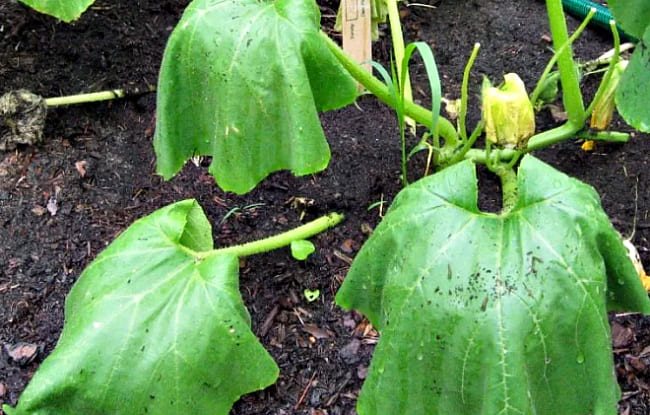

- If the plant is weak, with sluggish and poorly growing shoots, it makes sense to treat it with Succinic acid, according to the instructions.
- Poor seed germination makes it clear that the soil is not rich in microelements. In this case, you can use this natural germination and growth stimulant.
- Any weakening of the garden culture, susceptibility to diseases and poor productivity are the main indications for use.
Why do gardeners make fertilizing and watering with succinic acid?
Succinic acid is chosen as a supplementary feeding. It cannot replace the basic fertilizer, but it makes it more efficient. Due to this, the introduction of dressings can be significantly reduced.
There are several main reasons and purposes for which gardeners feed and water the seeds or seedlings with bicarboxylic acid.


- At the planting stage, the seed is pre-soaked in an acid solution in order to activate germination.
- Cutting treatment improves root formation.
- Treatment of roots and shoots strengthens the immune system and promotes active growth.
- Protecting plants from disease is another reason for the use of Succinic acid.
It does not eliminate disease, does not kill parasites, but it increases the natural immunity of plants many times over. Sometimes it is used in a vegetable garden or garden purposefully, to increase yields and improve the taste of fruits.
Precautions for handling succinic acid
The drug is not toxic either to living beings or to the environment. However, it is unlikely that your eyes or skin will respond with gratitude when such a product gets on them. First aid in both cases is rinsing with water. If it enters the stomach, there should be no concern, this agent is used internally as an antiviral and antibacterial. After washing, the skin can be lubricated with any anti-inflammatory cream. It is not recommended to use a powder that is more than three years old. It is best to work with gloves and to observe the dosage for safety reasons.
Application for street and garden crops
The finished concentrate is usually used in several stages. First, the seeds and seedlings are pre-prepared, and then spraying is carried out to stimulate growth.
The gardener's guides tell you how to use succinic acid for plants in the process:
- First of all, seeds and cuttings are soaked, the crop of tubers and bulbs is processed immediately before planting.
- Then there is a regular process of watering the soil.
- Finally, the above-ground part of the crops is sprayed before and after flowering.
Thus, the yield increases, as well as the concentration of nutrients in the fruits. At the same time, the flowers become more luxuriant, possess greens of the best color and do not fade longer. Biostimulation with succinic acid prevents the occurrence of mass diseases, and also protects against parasites and increases the endurance of crops.


Basic properties
Succinic acid has the following beneficial properties:
- participates in the stimulation and regulation of plant growth;
- increases the synthesis of chlorophyll in foliage;
- promotes the assimilation of applied dressings;
- participates in the formation of a protective layer, which prevents the negative effects of toxins and excess accumulations of nitrogenous substances;
- improves soil microflora;
- increases the viability of plants when exposed to unfavorable factors;
- reduces the risk of plant diseases.
Let's consider further how to dilute succinic acid.


Correct preparation of the solution
The procedure is not as complicated as it might seem at first glance. Succinic acid for plants is used in the form of a solution of crystals diluted in water. The permissible concentration is of two main types used in horticulture.
- Standard option. Stir 1 gram of crystals of succinic acid for each liter of water.
- Reduced version. Each gram of crystals is first diluted in a relatively small volume of warm water, and then the required amount of liquid is added.
It should be noted that even small concentrations of succinic acid show their sufficient efficiency during work. Even a solution with an active ingredient content of 0.02% should be sufficient for all purposes. This concentration is achieved by mixing 1 gram of product crystals with 2 liters of water. Also, do not be afraid that the plants will overdose. The instruction for succinic acid for plants says that they can assimilate only the amount of substance they need, and give the remains to bacteria in the soil. However, the manual mentions that you should not constantly break your concentration. This approach will negatively affect plant health.
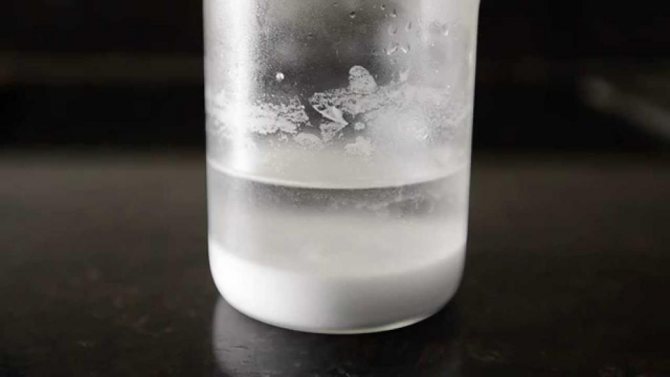

How to work with the solution
Knowing how to plant and how to water flowers with succinic acid can greatly improve their growth and appearance. But when using it, it is very important to follow some rules:
- It is advisable to use a ready-made working solution as soon as possible. You cannot store it for more than two to three days.
- Feeding flowers, especially orchids, is often not recommended as it is impractical.
- When preparing a solution of this acid and processing flowers, smoking and drinking are prohibited. It is undesirable to do this in the presence of small children.
- It is recommended to take precautions to avoid getting the solution in the eyes, as this can cause inflammation of the mucous membrane. If this happens, they must be thoroughly rinsed with clean water.
Application procedure
Yantarin for plants is used by spraying assimilating surfaces (green foliage and stems), watering under the root and manual processing without spraying (for indoor): wiping with a swab moistened with working solution, bathing the roots, etc. Spraying is carried out according to the usual rules, but it is better to time it for the evening time: there will be less losses of the drug from irradiation by sunlight, and by the morning, when bees and wild pollinators fly, its residues on flowers will not bring significant harm to them.
Instructions developed by the manufacturer for the use of Yantarin in private household plots for open field crops are given in the table, with the addition of dosages in%.


Amateur growers, in addition, successfully use succinic acid for irrigation under the root of seedlings, see video:
Video: the use of succinic acid for seedlings
Species of fruit and vegetable plants, which are perennials in the wild, but cultivated as annuals, for example, respond to this stimulant especially readily. tomatoes:
Video: the effect of succinic acid on tomatoes
In either case, instead of medical succinic acid in tablets or agrotechnical in powder, liquid Yantarin VRK is quite applicable. How the dosage tableted in the VRK is recalculated is indicated above. To calculate the dose of powder, you first need to determine the weight dose of 100% powder from the tabular concentration:
- 0.0025% - 0.25 g / 10 l;
- 0.0125% - 1.25 g / 10 l;
- 0.013% - 1.3 g / 10 l;
- 0.0015% - 0.15 g / 10 l;
- 0.00075% - 0.075 g / 10 l.
Next, the resulting "pure" value is divided by the weight content of the DV in the powder preparation or multiplied by its inverse:
- 90% - divide by 0.9 or multiply by 1.11;
- 80% - divide by 0.8 or multiply by 1.25;
- 75% - divide by 0.75 or multiply by 1.33;
- 60% - divide by 0.6 or multiply by 1.67, etc.
Orchid savior
Of the tens of thousands of orchid species, only a few take root in ordinary living rooms, and even then they often get sick, and achieving their year-round flowering is a triumph of a florist.The reason is the growing conditions of wild ancestors. Highly decorative orchids come from the "lungs of the planet" - tropical rain forests. Much less decorative orchids of temperate latitudes grow, as a rule, in the depths of forest thickets, where there is more oxygen in the air and much less pollution than on the edge of the forest, and even more so in the city. If the temperature and humidity regime for orchids in the living room can still be adjusted, then there is simply nowhere to take "Caribbean air" there. In this case, the use of succinic acid will help tropical beauties get by with what they have, and Amber will greatly facilitate and simplify the processing of plants.
The drug Yantarin VRK for orchids is applicable in several ways, according to the state and conditions of plants:
- Stimulating root watering of sluggish and / or non-flowering healthy orchids. The frequency is 3-4 weeks. It is carried out only during the period of active vegetation of plants! Watering sleeping orchids with a stimulant will kill them! Dosage - 0.1 g of 100% succinic acid per 1 liter of water, or 20 ml of Amber. The latter is immediately, with stirring, dissolved in irrigation water. Watering is carried out in a thin stream from a watering can without a grid, gradually, in small portions, so that the next dose of the solution is completely absorbed into the substrate. The interval between topping up is 1-3 hours. Watering until the substrate is completely saturated can be extended on the second day, but already on the 3rd day the irrigation solution will become unusable. Watering is stopped when an excess of solution begins to flow out from under the substrate. If the plant is in a pot with a saucer or pots, after 1-1.5 hours. after the last topping up, the excess solution must be drained. From under a plant in a deaf container (for example, in a flask), or grown on a synthetic substrate, the excess solution must be taken through a siphon from a thin hose (simply sucked off). It is undesirable to drain the excess by tilting the dishes: the plant is alarmed, and part of the residue will go back into the substrate.
- Soaking the roots before planting or when transplanting; carried out as a rule in conjunction with wiping the leaves (see below). The solution is the same as in the previous one. case. The roots of healthy normally vegetating plants are soaked in it for half an hour; if the transplant is made because the orchid is withering away - 2-2.5 hours.
- Wipe the leaves - a cotton swab is moistened in the same solution and squeezed slightly. With one hand, the sheet is held at the base through cotton wool, because getting the solution into the axils of the leaves is unacceptable! With the other hand, rub the sheet with a swab with a solution on both sides from the base to the top, gradually increasing the pressure so that the last drops (if any) roll off the end of the sheet.
- Resuscitation of specimens that have lost their roots by bathing the outlet. Solution - 0.4 g / 1 L of water (80 ml of Amber per 1 L of water). Processing - immersion of the plant "upside down" in the solution so that it does not fall into the leaf axils. Processing time is half an hour. Repeat every morning (early, as soon as daylight is established), until rudimentary roots appear. The duration of the treatment cycle is up to 90-100 days. upon recovery - soaking the roots (see above), planting in the substrate and, after 2-3 weeks, stimulating watering (also see above).
- Resuscitation of plants not completely deprived of roots. Applicable for specimens that have preserved at least root tubercles. The root collar of the orchid is immersed in the same solution (80 ml of the drug per 1 liter of water) every morning for 2-2.5 hours. Make sure that the solution does not get into the axils of the leaves! The duration of the treatment cycle is the same. When the roots grow up to 4-5 cm (the length of a matchbox) - planting in a substrate that stimulates watering.
Note: Orchids reanimated with Amber or other growth stimulants should not be planted in deaf dishes or artificial substrates until constant flowering is established.
Amber and garlic
Stimulating watering, bathing and manual treatment of orchids with Amber will be more effective if the working solution contains traces of free sulfur, becauseit is an essential component of the tricarboxylic acid cycle, see above. The simplest way to add sulfur to the Yantarin solution at home, without overdoing it, is to cook it in a garlic infusion (water extract); in addition, garlic extract, as you know, is also a good prophylactic fungicide. For the use of succinic acid with garlic for orchids, see the video:
Video: watering orchids with garlic and amber
Note: by the same or similar methods, with the help of succinic acid, you can bring back to life other dying indoor plants, see the plot:
What does it consist of and what does it contain
Succinic acid (butanedioic, ethane-1,2-dicarboxylic) is a saturated dibasic carboxylic acid. It is a metabolic agent available either in powder form or in tablet form. Succinic acid for plants contains impurities of iron, chloride and sulfate. The useful properties of the product are provided by acetylamino succinic acid.
This organic compound can be found in brown coal, resin, amber or any products of animal and plant origin. For example, in sugar beets and cane, aged wine, oysters, rye, yogurt and kefir, unripe berries and brewer's yeast. The composition of the preparation provides, in turn, faster growth of plants and an additional level of immunity for them.
